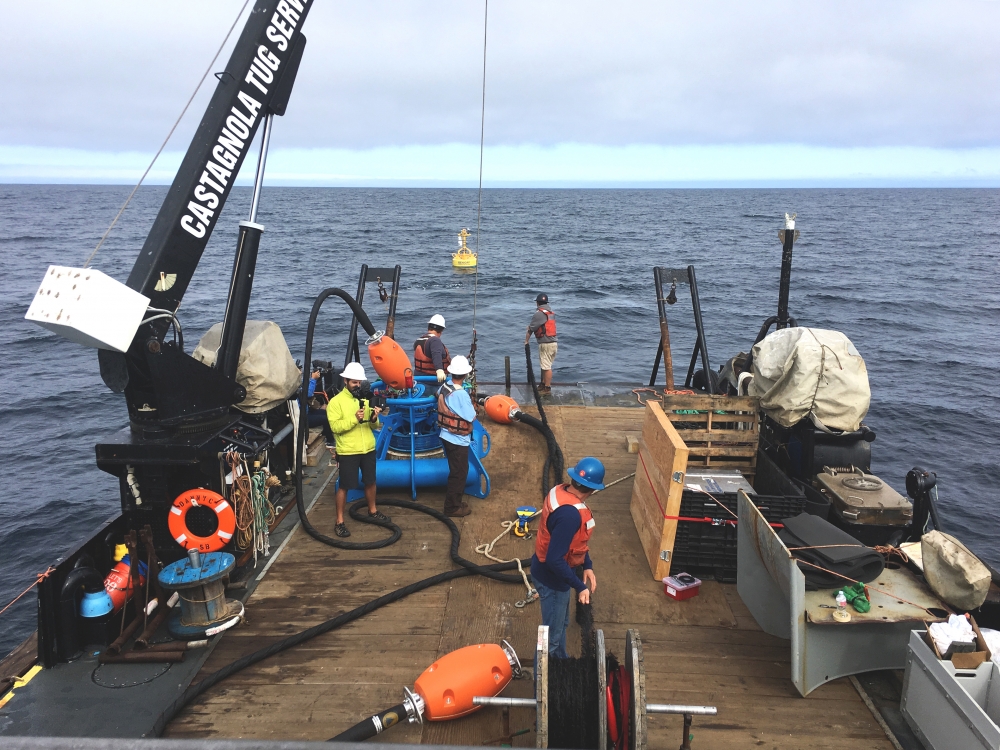
Mic Drop
The song of the blue whale is haunting — sonorous, deep and often so low in frequency that our ears can pick up only parts of it. A humpback’s call, while also often out of human range of hearing, has more variation. These chatty cetaceans burble and squeak and grunt at each other. Loud, and meant to propagate over long distances, whale songs are broadcast far and wide into the open ocean, indicating the animals’ presence and their relationship to their surroundings.
There are many possible reasons, scientists say, why blues, humpbacks and other varieties of whale vocalize. It could be for courtship, or a bit of swagger. It could be to locate each other over long distances, or to keep each other close. Their songs could be a series of status updates and spot reports, as the animals move along on their yearly migrations between breeding and feeding grounds.
All the reasons whales sing are not definitively clear, but with help from some enterprising ecologists from UC Santa Barbara, Woods Hole Oceanographic Institution (WHOI), Scripps Institution of Oceanography, and Texas A&M University, their songs can now be put to another important and definitive purpose: to save their lives.
Members of the scientific collaboration recently dropped state-of-the-art acoustic monitoring equipment into the Santa Barbara Channel, which, when coupled with artificial intelligence, could signal the presence of these creatures in the heavily trafficked corridor. Once post-deployment adjustments are made and bugs fixed, the equipment will take data and measurements at regular intervals.
The project is part of UC Santa Barbara’s Benioff Ocean Initiative (BOI), which aims to implement science-based solutions to some of the most pressing problems in our oceans.
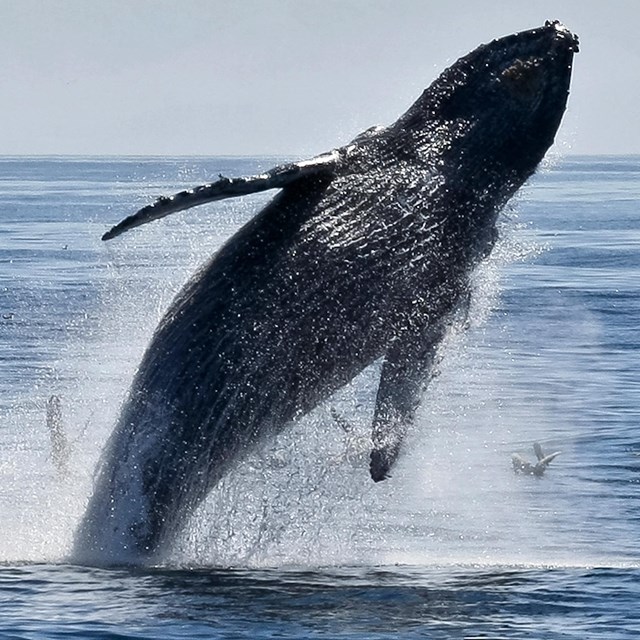
A humpback whale breaches. Photo by Tim Hauf/National Parks Service
“There are a number of species of endangered whales on the west coast of North America in the Pacific Ocean that are facing a bunch of threats,” said UC Santa Barbara marine ecologist Douglas McCauley, who also is the director of BOI. These slow-growing majestic creatures, who are essential to their ecosystems, are not only still trying to recover from two centuries of intensive whaling while facing down emerging climate change-related impacts to their food sources, they also are frequently the victims of collisions with large vessels. Ship strikes, in fact, are currently a leading cause of death for large whales.
According to McCauley, 2018 was the worst year on record for the number of ship strikes. Off the coast of California alone there were fourteen confirmed such strikes— a number based only on what is reported and confirmed, he explained. Scientists estimate that the actual number is much, much higher: More than 80 endangered whales are thought to be killed each year by ship strikes off the entire West Coast. And with 11 confirmed strikes off the California coast by June, 2019 “has been on track to be just about as bad or worse” for the mammals.
“The shipping companies, of course, want to do business, and need to do business,” McCauley said. In fact, a huge part of the global economy is driven by ports that move goods up and down the West Coast, to and from the ports of Los Angeles and Long Beach. The Santa Barbara Channel, in particular, sees a high concentration of these large vessels, which squeeze between the mainland and the islands at the rate of roughly 2,700 per year. There have been positive interventions, he pointed out, among them a voluntary agreement by the vessels to slow down while in the Channel. The passive acoustic monitoring project, McCauley said, aims to build on these successes to empower researchers, shipping companies and others interested in the safety of the whales with more data with which they can plan and manage traffic in the Channel.
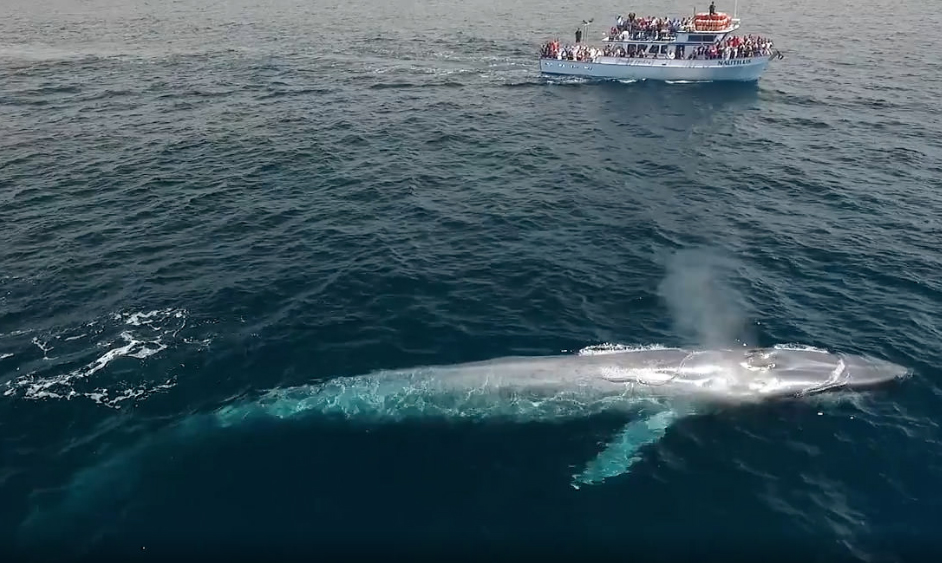
The Santa Barbara Channel is a hotspot for blue whales. Credit: Earth Media Lab/National Parks Service
Blue Serengeti
There’s a long history of interaction between whales and people along the Santa Barbara Channel. The seafaring native Chumash were known to have taken advantage of the occasional whale carcass washed ashore. However, it was with the whaling industry toward the end of the 19th century that the carnage began, as whale blubber was still the primary source for oil, while bones and baleen yielded material for other goods. In fact, just a few steps from the UCSB campus, on Goleta Beach, there once operated a whaling station.
These days, whale commerce in the Channel is generated by whale watching cruises, in which a tight network of smaller commercial vessels take visitors out during the spring and summer months to witness the clockwork-like migration of fins, humpbacks, blues and grays.
“The Channel is a blue Serengeti for whales,” McCauley said, referencing the region in Africa known for its massive annual migration of wildebeest. Little do the surfing, beach-going and fishing public know that just a mile or so beyond the surf an underwater Great Migration occurs every year, he said.
And perhaps the whales’ millennia-old migration would go largely unnoticed, were it not for the location of feeding hotspots right in the Channel, and right at the shipping lanes. Thanks to the meeting of the cool northern California Current and the warmer southern California Countercurrent in the western section of the Channel, unusually high concentrations of nutrients are brought upward from the depths, increasing biological productivity.
“And then you have all of this forage — sometimes krill, which are the favorite food of the blue whale, sometimes anchovies, which are one of the favorite foods of the humpback whales,” McCauley said. Despite the known potential for crowded conditions, whales and shipping vessel captains often can’t sense each other before it’s too late. And while the ships suffer little to no damage, for the whales — blue whales in particular, of which there are only an estimated 1,600 off the California coast — contact is deadly.
Underwater Hi-Fi
This is where technology comes in. Sound travels four times faster in water than it does in air, and over millions of years of evolution, whales and other cetaceans have adapted to this phenomenon with highly sophisticated anatomical structures that both project and receive sounds over long, often dark and empty distances — their primary form of communication. Visibility may be limited in the Channel but it can get loud down there.
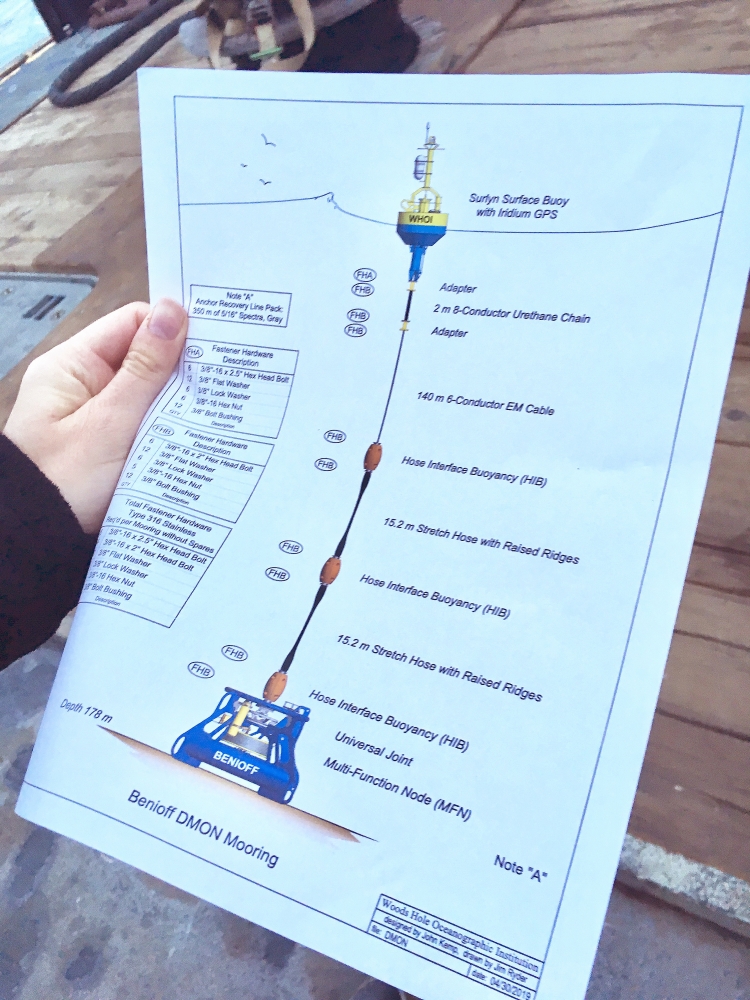
A diagram of the equipment deployed in the Channel. Credit: Sonia Fernandez
The collaborators — McCauley, WHOI biologist and oceanographer Mark Baumgartner and Texas A&M marine bioacoustician (and UCSB alum) Ana Širović took advantage of this aspect of whale communication by embedding a hydrophone in the Channel at a record depth of almost 600 feet. It’s a setup that includes acoustic equipment moored to the seafloor to listen for whale calls, which are filtered by onboard artificial intelligence algorithms that have been trained on Sirovic’s extensive library of West Coast whale calls — whalesong “standards,” if you will. The signal will be conducted via cable to a buoy at the surface, and then relayed to Woods Hole and Texas A&M for further analyses.
Deploying the gear was a feat that required the specialized skills of WHOI’s Mooring Operations and Engineering Group, who assembled the components on the deck of the DannyC utility vessel in the Santa Barbara Harbor. While not their first deployment of the acoustic equipment — they have over the last several years moored several such buoys off the East Coast — the Santa Barbara Channel buoy is the first West Coast deployment and the deepest mooring to date.
And it brought a new challenge: how to dampen the unintentional acoustic effect of the unusually long cable.
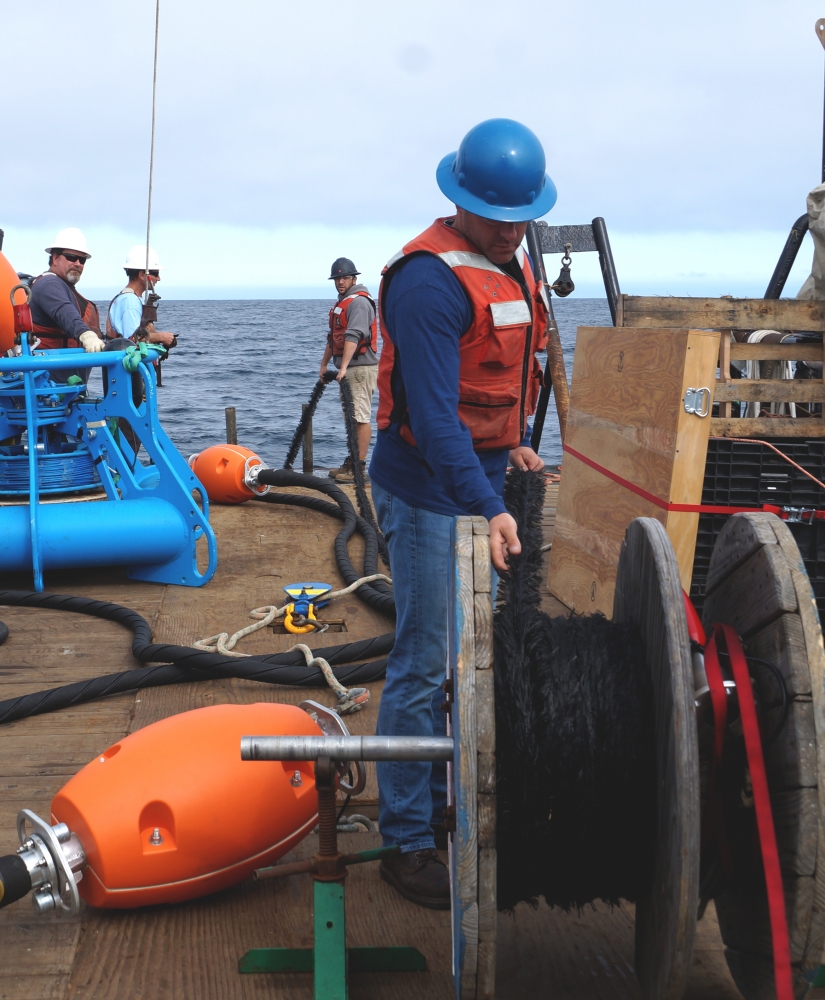
A segment of the line is covered in a "furry" cladding to attenuate vibration. Credit: Sonia Fernandez
“The line is like a giant guitar string,” McCauley explained, “so it strums when the current goes by and creates an interference that has to be somehow dampened.” The solution? Clad the line in a nylon “fur” to attenuate the vibration.
Assisting with the literal heavy lifting, the crew of the DannyC utilized their intimate knowledge of the Channel and its waters to make sure the equipment hit its mark a few miles off Santa Cruz Island, toward the midway point of the whales’ passage.
Future Uses
The real-time acoustic monitoring is only one component of an anticipated whale monitoring package that also includes thermal monitoring and a forecasting model, which will utilize data from varied sources including weather reports and observations from citizen scientists and whale monitoring institutions along the west coast. The goal is to integrate everything into a website that could serve as a one-stop shop for people curious about the whales’ whereabouts, and, hopefully, give shipping companies the information they need to safely share the water with the whales.
“Our industry colleagues have been very receptive to this work thus far — nobody wants to kill or injure animals as majestic and ecologically important as a blue whale,” McCauley said. “We’ve already been talking with partners on the West Coast about places where we can put another version of this system.” The next logical West Coast whale/vessel collision hotspot would be San Francisco.
Though still in the early stages, and at the moment laser-focused on addressing the ship strike issue, this technology has other possibilities. The same system, McCauley said, also has the potential to serve as the basis for tracking whales as the climate changes, which may cause food sources to shift, which in turn could trigger changes in the migratory habits.
“We’re in this moment right now where the oceans are changing rapidly,” McCauley said. Whales are already struggling to adapt to a changing food web, he pointed out, and good data could “provide answers to questions about how these increasingly imperiled whales are finding ways to survive in these fast-changing oceans.”
More research stories from the Santa Barbara Channel can be found in The Current's featured compilation, Channel for Discovery.



